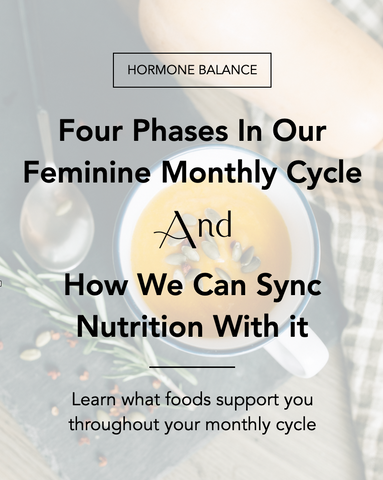
There are 4 phases to our feminine monthly cycle: Menstrual, Follicular, Ovulatory, and Luteal. In each phase our body goes through hormonal changes, and is in need of specific nutrients and self-care practices to function at its optimal best. Try to tend to the requests of your body from week to week. As you become more aware and in tune, your body will guide your intuition so you will know how to care for it. All cycles are slightly longer or shorter than others. In this post we will refer to an average 28 day cycle. Everyone has slightly different cycle and phase lengths, so you may need to adjust to fit your cycle needs.
Before we begin it is important to note that your body needs real, whole foods throughout the entire month. Do your best to avoid processed foods, alcohol, sugar, artificial sweeteners, highly caffeinated beverages, or industrial oils (canola, soy, etc).
Think of each 28-day cycle as representing a year. Each phase corresponds to a season: Winter, Spring, Summer and Fall.

Menstrual Phase (Days 1-5ish)
The Menstrual Phase starts on day 1 of your cycle. This is when you are in a full bleed, not spotting. Winter is the season associated with this phase. Your body is shedding the endometrial lining and hormones and energy levels are at an all time low. Take this time to rest for the first few days. As you respect your body with its needs during this phase, it will gift you back with full energy, clarity and drive later in the month. You may feel that you want to be alone and hibernate from being around people. Learn to love yourself during this time. Some healing activities may include: journaling, taking warm baths, spending time in nature, and slow-paced yoga.
Nutrition for the Menstrual Phase
This is the time to start eating warm and easily digestible foods. It's important to keep your blood sugar low. Look for meals that are nutrient dense, including healthy fats, and protein. Add minerals back into your body by finding foods high in iron, magnesium, and B vitamins. Incorporate sea salt with every meal. Include anti-inflammatory, antioxidant, immune boosting foods. Remember to hydrate! Drink 2 liters of water or more per day.
Foods to enjoy during this phase include:
Bone Broth
Dark Leafy Greens
Roasted Root Veggies
Cage-free Eggs
Grass-fed Red Meat
Avocados
Reishi
Sprouted Nut Butters
Pumpkin Seeds/Flax Seeds
Dandelion Tea
Blueberries/Cranberries
Wild Oily Fish (salmon, mackeral, cod, sardines, etc)

Follicular Phase (Days 6-12ish)
The Follicular Phase starts when you end your bleed. During this phase your energy will bloom back and you'll feel renewed as estrogen and progesterone levels are rising. Slowly come out of hibernating. This is a great time to focus and start getting organized. Some healing activities may include: researching new things, organizing your calendar, going on a hike, scheduling a fun night out & bike riding.
Nutrition for the Follicular Phase
Your body will energize lighter foods best. Lean towards anti-inflammatory foods to help keep inflammation low in your body. As hormones are producing, inflammation can disrupt them and may cause a delay in ovulation during the next phase. Include foods that are probiotic-rich and high in omega-3s, phytoestrogens, and zinc.
Foods to enjoy during this phase include:
Beans
High Quality Protein Powders
Sprouted lentils
Moringa
Zucchini/Artichoke/Green Peas
Pasture Raised Chicken
Pumpkin Seeds/Flax Seeds
Citrus Fruits
Raw Sauerkraut
Red Raspberry Leaf Tea
Cage-free Eggs

Ovulatory Phase (Days 13-16ish)
As the Ovulatory Phase starts, hormones are at their highest. Estrogen peaks and luteinizing hormones arrive to begin the release of an egg. You are feeling very social and confident. Some healing activities may include: trying a spin class, hanging out with friends and connecting with others, going for a run outside, and sweating it out with some strength training.
Nutrition for the Ovulatory Phase
Focus on foods that will help your body maintain balanced estrogen levels. It's a great time to eat raw foods. Add extra greens to support the liver. Increase fibers to help excrete excess estrogen during this transitional phase. Include foods that contain vitamin B, vitamin C, and antioxidants.
Foods to enjoy during this phase include:
Salads
Green juices
Organic Lamb
Maca
Cruciferous Vegetables (cauliflower, kale, broccoli, etc.)
Sunflower Seeds/Sesame Seeds
Bell Pepper
Quinoa
Berries
Salmon/Tuna

Luteal Phase (Days 17-28ish)
Starting the Luteal Phase hopefully you have successfully ovulated as progesterone is now present. If the egg isn’t fertilized, hormone levels decrease and the menstrual cycle starts again. You may notice your energy levels beginning to lower and your mood may fluctuate. Some healing activities may include: movie night at home, wrapping up any projects, cleaning & organizing, and pilates.
Nutrition for the Luteal Phase
As your body starts to nest, it will crave warm foods. Focus on foods high in vitamin D, calcium, omega-3s, B vitamins, selenium, and magnesium-rich. Sugar cravings can creep up, so eat balanced meals with additional complex carbohydrates.
Foods to enjoy during this phase include:
Spinach
Cabbage
Apple/Peach/Pear
Sunflower Seeds/Sesame Seeds
Sweet Potatoes
Ashwagandha
Peppermint Tea
Squash
Dark Chocolate (raw cacao rather then cocoa)
Pasture-raised Turkey
____________________________________________
We hope this post was helpful as you begin your journey in getting back in balance with your hormones and more in sync with your body’s natural rhythm.
The content on this website is for informational purposes only and should not be interpreted as medical advice. Information on this website and related social media has not been evaluated by the Food and Drug Administration and is not intended to replace or supplement professional medical treatment, advice or diagnosis. Always consult a licensed medical care provider to discuss your medical concerns and check with your healthcare provider before trying any information provided in this content.

